I visited the Museum of London this week – the first time for quite a while and, as I wandered round, I found myself thinking that it might be interesting to look at how ordinary people chose to commemorate what was going on in their lives – for good or ill. So I shall begin in 1600 in London with a Delftware plate celebrating the long and prosperous reign of Queen Elizabeth I.
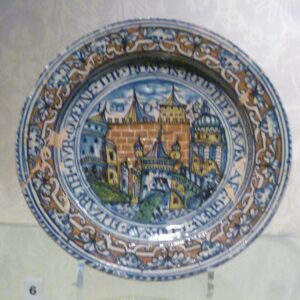
Elizabethan Delftware plate, 1600
The legend around the edge reads: THE ROSE IS RED THE LEAVES ARE GRENE GOD SAVE ELIZABETH OUR QUEENE 1600. A picture of a castle fills up the centre – possibly the Tower of London, or maybe it’s just a generic tower symbolizing a strong and successful reign. After the horrors of the Wars of the Roses; followed by the bloody and destructive reign of Henry VIII, the country was, more or less, at peace. There was much to be proud of: Shakespeare and the Elizabethan theatre; world exploration and the expansion of English trade and influence; the destruction of the Spanish Armada – and so on. At least, this is how the Queen’s contemporaries might have seen it.
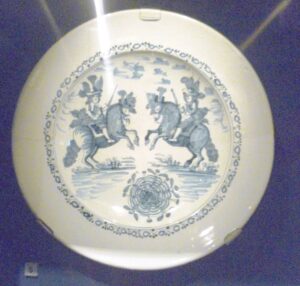
Plate showing a Cavalier fighting a Roundhead: but which is which? Perhaps it’s the Cavalier (left) who is waving the sword; the Roundhead (right) holds a more practical fire-arm.
No-one could have foreseen the horrors of the English Civil War which broke out just under forty years after the death of Queen Elizabeth in 1603, when, in 1642, the country was divided between the Royalists who supported King Charles I and the Divine Right of Kings, and the Parliamentarians (the Roundheads), who wanted more say in the running of the country. As the country went to war with itself, families were split apart. A rising middle-class, especially in the towns and cities, were asking awkward questions about who had the power and how the country should be governed. It was a long and bitter conflict.
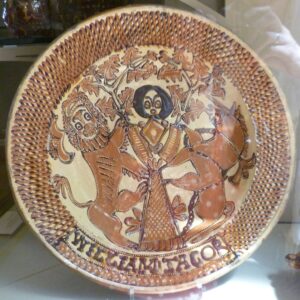
This lively plate shows a teenage Prince Charles, son of Charles I, hiding in the Boscabel oak tree whilst Roundhead soldiers search for him below. Plate from Fitzwilliam Museum, Cambridge
Every country needs national stories, and England is no exception. Alfred burning the cakes; bad King John losing the royal treasure in the Wash; even Robin Hood. (The stories don’t have to be true.) The young prince’s series of adventures escaping the Roundheads and, with the aid of ordinary people, eventually finding a ship to carry him to exile in France, was perfect.

Cup to commemorate the crowning of Charles II, 1660
The new king could be counted as still young when he returned from exile, landing in Rochester on his 30th birthday, 29th May, 1660. He is wearing armour – a sign that he’s up to the job. He has a long, fashionable wig – he’s been living in Paris with his cousin, King Louis XIV, and somehow he doesn’t look like a puritan Roundhead. England under the Commonwealth was fairer, more sober and the country had begun to recover economically. On the other hand, it was also dull: celebrating Christmas was banned and dancing on the village green was frowned on. Puritans might be suspicious of Charles’s morals but at least he could never be described as dull.

‘East India Sugar Not Made by Slaves’ sugar bowl from British Museum
The rise of the British Empire in the 17th and 18th centuries was founded on the Atlantic Triangle: the trade between Britain, West Africa and the West Indies. Britain sold cloth and tin ware to West Africa where it was exchanged for slaves. The slaves were taken in slave ships to the West Indies and sold as labour for the sugar plantations, and sugar was brought back to Britain where it was refined and sold both in Britain and on the Continent. This economic triangle was immensely profitable.
Human history had had slavery for thousands of years: the Romans had slaves, the Vikings had slaves, the Arabs had plundered Africa for slaves for centuries; and in the 17th century, maritime countries, like Portugal and England, joined in. There were slaves in the Bible; it seemed like the natural human condition and it took several hundred years before moral doubts crept in.
The mug pictured above is one of the ways ordinary people could express their views and show support for those who wanted to abolish slavery.
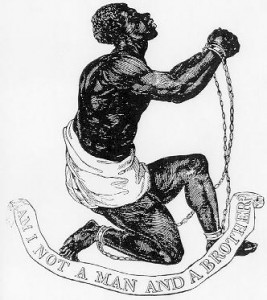
‘Am I not a man and a brother?’ This powerful image helped to get across the Anti-Slavery Society’s message. Courtesy of Wikipedia
Although the Mansfield Judgement declared in 1772 that owning slaves was illegal in England, it was slavery which made Britain’s prestige and prosperity possible; it was only in the late 18th century that Quakers and other thoughtful Christians began to oppose slavery as both inhumane and morally abhorrent. It was largely due to the efforts of the Abolition Society founded in 1787 by William Wilberforce and others that the slave trade was abolished in Britain in 1807. But, even when the slave trade itself had been abolished, slave emancipation did not automatically follow, as had been assumed. In 1823, the Anti-Slavery Society was formed and finally, in 1833, 46 years later, slavery was abolished throughout the British Empire.
Slavery has cast a long shadow over British history, which is only now beginning to be properly addressed.
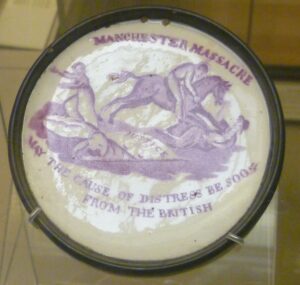
Manchester Massacre, 1819
This plate commemorates the peaceful open air mass meeting in Manchester during the campaign for parliamentary reform which was dispersed with such unnecessary force that 11 unarmed civilians died and hundreds were injured, many by sabre cuts. The incident was soon called the ‘Peterloo Massacre’ in ironical reference to the bloody Battle of Waterloo only four years earlier. The incident became a symbol of repression.
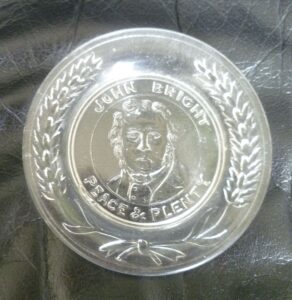
Glass plate commemorating John Bright (1811-1889) the Liberal M.P., orator, free-trader and political reformer. 12.cms. In the author’s collection.
I was delighted to find this in an Oxfam shop a couple of years ago. Bright fought for an astonishing number of reforms: all of which aimed to give ordinary working men a fairer deal, starting with political reform and the repeal of the Corn Laws which kept the price of corn (and thus bread) unfairly high. His slogan PEACE & PLENTY is underneath his picture, and a wreath of laurel leaves, symbolizing praise, encircles him.
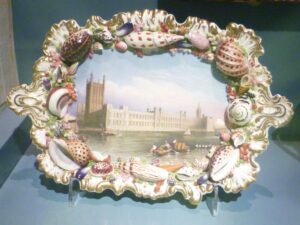
Porcelain dish with a shell border, showing a proposed view of the new Houses of Parliament after the devastating fire of 1833 had destroyed much of it.
The new Houses of Parliament did not actually end up looking like this, of course. For a start, Big Ben is missing; and Charles Barry’s actual roof-scape is more Gothic – he believed that the Gothic style was purer and more Protestant somehow than the Classical. Others disagreed. I liked the exuberant shell border.
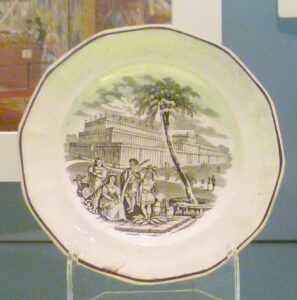
Vase commemorating the 1851 Great Exhibition and the Crystal Palace
The Great Exhibition, the brainchild of Albert, the Prince Consort, set out to showcase industrial products from Great Britain and the Continent within Joseph Paxton’s specially constructed glass house which swiftly became known as the Crystal Palace. (It was three times the size of St Paul’s and contained over 1,000,000 square feet of glass.) Over 100,000 objects were displayed. And the number of countries exhibiting rose: the Americans had new machinery to show, and German and French industrial exhibits were also prominent.
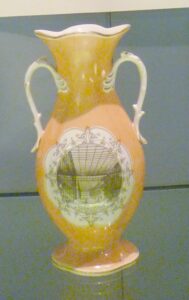
Vase commemorating the Great Exhibition of 1851, and depicting the interior of the Crystal Palace
Various kill-joy pundits foretold disaster: hordes of the ‘great unwashed’ would get inside the Crystal Palace and riot; glass would be broken, etc. But, in fact, it was a triumph. Visitors could have tea and cake but no alcohol was allowed. Special excursion trains brought sober working people to London in their thousands to buy one of the shilling day tickets – the Exhibition had over 100,000 visitors a day by the time it ended in October.
The overall profit was over £180,000 – enough to build the Kensington Museums, the Royal Albert Hall and a number of Royal Colleges.
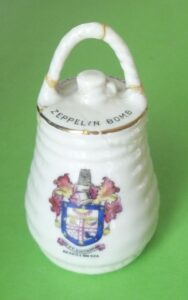
Pottery Model of Zeppelin bomb (9 cm. high) in author’s collection
I bought this in a church sale many years ago. It cost me 6d. It’s a pottery model of one of the Zeppelin bombs which dropped on the Sussex coastal town of Bexhill-on-Sea in 1916, during the First World War. On the top it reads: MODEL OF GERMAN ZEPPELIN BOMB. On the front is the coat of arms of Bexhill-on-Sea.
Shelley China 177 made a number of commemorative pottery bombs from towns all along the south coast of England to mark where various bombs fell during the First World War. Mine, alas, is rather the worse for wear: my son, when a toddler, threw it before I could stop him. Par for the course with toddlers, alas, and I swiftly learnt to put breakable objects on higher shelves.
In a way, this small pottery bomb is similar to other objects I’ve shown in this post: it is a reminder of the dropping of a Zeppelin bomb, which killed innocent people. Like the plate depicting the Roundhead and Cavalier fighting dating from the English Civil War, and the plate showing the Peterloo Massacre in 1819, they all record a small piece of our National story.
All photos are by Elizabeth Hawksley and show objects in the Museum of London, unless otherwise indicated.
Elizabeth Hawksley
Please share this page...
Fascinating objects. It’s strange how the thirst for such commemorative material is still strong. I wonder which of our objects will wind up as nostalgic rem8nders in a couple of hundred years.
Thank you for your thoughtful comment, Elizabeth. It’s an interesting point. I think that nowadays we express things differently – via slogans on T-shirts, say, or graffiti on walls, or even tattoos!
Very interesting. Please notify me of future posts.
I’m delighted that you found my post of interest, Peter.